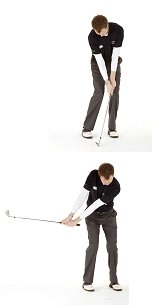The Ultimate Pitching Guide Part 1: Setup
Instruction
Learn the proper set up to help you make solid and consistent contact with ball – and maybe even impress your playing partners by making the ball check and spin.
What’s the easiest way to knock shots off your golf handicap or improve your scores? I’ll give you a clue, it’s not hitting your drives an extra 20 yards. You play the majority of your golf shots on or around the green, so why not practice that part of your game more. If you hit every shot from within 100 yards with the aim of the next shot being a makable putt, then your scores will tumble. Having a solid golf short game has the added advantage of taking some of the pressure off your approach play.
The Guide
This guide is specifically about pitching (not chipping). For clarification, any distance that requires less than a full swing (typically anything under 80-100 yards), we’ll call a pitch shot. Anything around the fringes or the apron of the green (about 25 yards and in from the pin), we’ll call a chip shot.
This pitching guide will in four articles cover the fundamentals like proper set up, distance control and club selection. We’ll also look at some common faults – like thinning or topping your pitch shots. Learning how to hit pitch shots with both accuracy and consistency will have a major impact on your golf game. It’s a great confidence booster to know that if you hit a wayward drive and can’t make the green in two, you still have a good chance of saving par because your pitching is so good.
Pitching should be a skill that most golfers can master to a very reasonable level of competence – it requires less timing and co-ordination compared to full irons or drives and less physical strength and flexibility too. However, most amateur golfers lack confidence over their pitch shots and are happy to land the ball anywhere on the green.
The Setup
In the first part of this mini How To Pitch Like A Golf Pro series, we’ll look at proper setup:
 For a pitch shots, take the same good setup that you do for full irons. However, we now want to replace the elements that help generate power and replace them with elements that promote feel and control.
For a pitch shots, take the same good setup that you do for full irons. However, we now want to replace the elements that help generate power and replace them with elements that promote feel and control.- You can reduce power and increase control on a sliding scale (which will help with your distance control) by adjusting the following elements of your set up:
- Reduce your width of stance
- Grip further down the club
- Reduce the length of swing
- With your lob wedge for example, a full shoulder width stance, gripping the club at the top of the grip and a full swing might send the ball 65 yards. Gripping half way down the grip, narrowing your stance and taking a 3/4 swing might send the ball 50 yards. Likewise, gripping right at the bottom of the grip, with a narrow stance and half swing might fly the ball 35 yards
- Hit some balls at the range with these 3 set up postions and with 3 different clubs (i.e. gap wedge, sand wedge and lob wedge). That will give you 9 pitching distances. We’ll take this a step further in the next lesson
- For shorter pitch shots where you’re taking a narrow stance and gripping right down the club, you should also open your stance (feet and hips pointing left of target for the right-handed golfer) and place more weight on your front side (about 60/40 favouring your front foot).
- Watch a summary video here.

